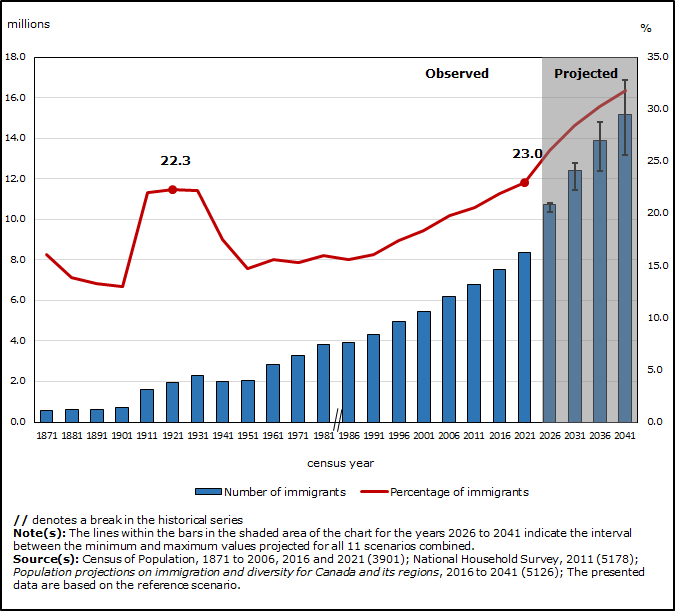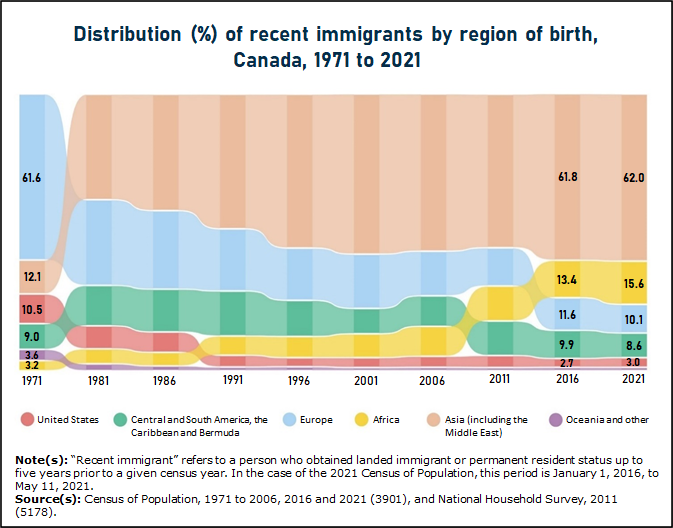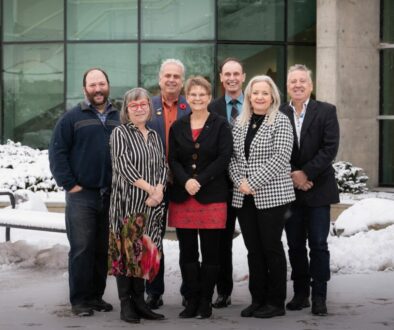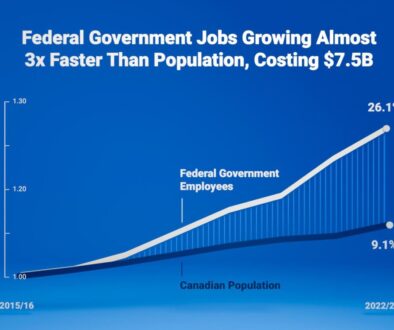Ten Reasons to Oppose Mass Immigration to Canada
1) Housing Crisis
This one is simple enough: prices are determined by the relationship between supply and demand. As Canada’s population has grown through large-scale immigration, which reached a rate of nearly 1.3 million in 2023 alone (when including non-permanent residents like foreign workers and international students), both home prices and rents have soared.
Vancouver, Toronto, and Hamilton are now the three least affordable cities in North America. In his 2010 book Millionaire Migrants, UBC professor David Ley found a positive correlation coefficient of 0.94 between Vancouver and Toronto house prices and net international migration. For more evidence on the relationship between immigration and housing prices, check out Madeline Weld’s excellent article on the topic: Blatantly Oblivious to the Blindingly Obvious.
The result is social chaos and displacement, with younger generations feeling locked out of the housing market and delaying having children, and elderly Canadians on a fixed income returning to work to meet rent or mortgage payments.

2) Strained Healthcare
This one is also pretty simple: immigrants need healthcare too! Adding large numbers of future patients from overseas every year is exacerbating the pre-existing problems with our healthcare system.
Though the population has grown by 5 million people in the last ten years alone, Canada has added just 167 medical residencies. In 2023, Canada accepted 471,550 permanent residents, as well as around 800,000 foreign workers and international students. Despite the federal government’s claim that the solution is to bring in doctors and nurses from overseas, in reality we only accept about 4,000 immigrant healthcare workers per year.
As a result, more than 6 million Canadians and counting do not have access to a family doctor.
3) Farmland Loss
Despite having the second-largest landmass in the world, just 4.3% of Canada is arable, and 90% of Canadians live in a winding line of settlements within 160 KM of the U.S. border. Most immigrants settle in this same strip, which drives urban expansion: 15 million acres of farmland have been lost since 1976. Ontario loses 319 acres of farmland every day. Since 2001, Canada has lost the equivalent of seven small farms per day.
This loss of farmland weakens Canada’s food security, forcing us to depend on importing food from other nations – in an increasingly fractious world order. It also fuels urbanization, threatening Canada’s beloved countryside landscapes, and the rural lifestyle many of us are attached to.
4) Crowding of Schools
Like so many effects of mass immigration, the overcrowding of Canadian schools is a function of the law of supply and demand – which our political elite is apparently unaware of! Simply put: provinces and school districts are being overwhelmed by large numbers of additional students from newly settled immigrant families. In Prince Edward Island, Charlottetown and Stratford received 375 newcomer students who were neither predicted nor planned for. Surrey, B.C., is considering putting schools in high rises!
To be sure, school crowding is not the fault of the immigrant families in question: both immigrant and native-born Canadians alike are the victims of the classroom crowding caused by an out-of-control federal immigration policy.
5) Foreign Interference
From the alleged Chinese interference in recent Canadian elections to the assassination of Khalistan separatist Hardeep Singh Nijjar outside a Surrey temple, Canada is now a hotspot for foreign interference. While politicians of all stripes have denounced the meddling of foreign states in Canadian affairs, none have explicitly linked it to the presence of large foreign diaspora populations on Canadian soil.
The fact is, the presence of large diasporas invites foreign interference. This is especially true of China, which considers all ethnic Chinese to be nationals of China – regardless of their place of residency. For Xi Jinping, overseas Chinese play an irreplaceable role in China’s rise. The link between diaspora populations and foreign interference appears to be an ironclad rule of geopolitics, and has been seen in Europe as well, with Turkish president Erdogan urging Turks in Germany to vote against German Chancellor Merkel after a diplomatic rupture between the countries.

6) Declining Living Standards
Large-scale immigration is touted as necessary to Canada’s economic success, but this could not be further from the truth. While Canada’s immigration-driven population growth does grow the Gross Domestic Product (GDP), it lowers GDP per capita. In other words, while the economic pie grows, most people’s slice gets smaller!
This process has gotten so bad that the National Bank of Canada released a report warning that Canada is in a “population trap” whereby any increase in living standards is impossible – a problem which usually occurs in emerging economies like India or Sub-Saharan Africa!
7) Urban Sprawl and Densification
The federal government describes immigration in abstract terms: addressing labour shortages, offsetting ageing populations, or growing the GDP. In reality, immigrants are not just workers, they are people – people who need a roof over their heads! To accommodate immigration-driven population growth, a large amount of Canada’s energy and wealth is spent endlessly building both single-family developments and high rises.
The urban sprawl strategy is most visible in places like Calgary, with new cookie-cutter developments being continually built on the surrounding prairie. Alberta saw a population boom of 184,000 in 2023 alone (with international migration accounting for far more than interprovincial migration), so this looks likely to continue. The densification approach is most apparent in British Columbia, which recently abolished single-family zoning in most communities to accommodate immigration-driven population growth.
8) Declining Social Cohesion
Social cohesion is a measure of the strength of the bonds linking members of a group to each other – and to the group itself. As ethnic and cultural diversity increases because of large-scale immigration, the number and severity of society’s cultural fault lines increases.
One way in which this is manifesting in Canadian society is brawls between or within diaspora groups. On September 2nd, 2023, about 150 Eritreans clashed in the parking lot of Calgary’s Falconridge plaza, armed with sticks and pipes. Similar clashes occured in Edmonton and Toronto. The origin of the disputes was a difference of views about the government in Eritrea. In November of 2023, viral videos emerged of a clash between Hindus and Sikhs on Diwali in Mississauga.
9) Incompatible Cultural Practices
Most of Canada’s immigration now comes from India, Asia, Africa and the Middle East. While culturally rich in their own way, cultures and religions in these regions often hold values diametrically opposed to those of Anglo Canadian and Quebecois society. The result is the import of behaviours incompatible with – or even offensive to – the Canadian way of life, such as:
- A furniture store in Richmond, B.C., advertising for a “Chinese sales person”.
- A daycare worker in the Quebec city region discovering, while changing a young girl’s diaper, that she had been the victim of female genital mutilation.
- The revelation in Quebec that three schools had set up Muslim prayer rooms, segregated by gender.
- The construction of a 55-foot tall statue of Hanuman, a Hindu god and “commander of the monkey army”, in Brampton.
- Discriminatory rental ads specifying that apartments or houses will be rented to “Indians only”.
- The controversial spread of massive Chinese “monster homes” in Vancouver.

10) Erosion of National Identity
By 2036, immigrants are projected to make up about 30% of the Canadian population. By 2050, roughly half the country’s population will non-white. In some areas, these projections have already been reached or surpassed. In Brampton, Ontario, 65% of the population is South Asian. Richmond, B.C., became majority Chinese in 2016. In Quebec, the French language is in serious decline because of large-scale immigration.
If immigration targets remain unchanged, there will be a dramatic change in the country’s ethnic, cultural, and linguistic composition. Many citizens, both native-born and immigrants, will be uncomfortable with a change at this rate and scale to the country they know and love. To make matters worse, the successive federal governments which have overseen Canada’s policy of large-scale immigration have never consulted Canadians on whether they actually want this kind of change.




Eva
April 13, 2024 @ 2:51 pm
A FEW RUMINATIONS ON HIGH RISES AND MEGA CITIES
It’s interesting how we believe current trends will continue for ever! I was watching a program about the need to build our cities ever upward — higher, higher ever higher sky scrapers because of our (for ever) growing world populations.
Speaking for Canada we know that our birthrate is so low we would barely replace our numbers naturally! Where’s the threat of an ever increasing population that requires the proliferation of mega high-rises in our major cities?
There would be no threat, were it not for the Trudeau government’s creating one via a proposed million newcomers every year!
Given that no one seems to care if we can feed any more people at a decent standard of living, I consider these policies irresponsible! I doubt we can expect manna from heaven, and our main food supplying countries (we are actually no longer food self-sufficient even now) might not be able to spare any of their food, if climate change continues and we don’t do anything sensible to adapt to it.
A recent BC Knowledge network program on the need for building ever higher and denser was totally distressing to me, and I find the attempts to convince listeners that these future ghost towns are green pretty unconvincing! In fact it almost sounded as if the speaker making this claim was not really convinced either.
It made me wonder if there wasn’t something missing in that argument. Something like humans being part of wild, living nature not a man made concrete jungle. Putting a few artificial patches of planting here and there is not the same. I would have said God-created nature, but not everyone believes in the supreme Creator any more. That is a shame of course, because then some tend to think they are god, and try to usurp the rights of others.To understand this misunderstanding, everyone needs to find and study “The secret revelation of John”, a document found in the desert of Egypt about 150 years ago!
But let’s not digress!
What concerns me, apart from the inhumanity of our current urban planning model, is the lack of forethought given to any and all potential disasters that could make these dense high-rise urban areas literally death traps!
Just recently some US cities lost all internet and electric power.
While the outage lasted only a matter of hours, it should be a warning signal. There are a number of causes why this sort of thing could be regional, or even continent wide!
Let’s just consider the natural ones: solar flares, for example. They increase and decrease periodically, and have been much more severe in several historical periods. In the view of people who actually understand this – unlike me – this could knock out all the energy sources we rely on in our man made civilizations.
So no power, no heating/cooling, no elevator service, no supply of necessities to our glossy cities. And given that vehicles now require electronic and internet inputs, probably no getting away to a safer area!
And what about electronic warfare? You could paralyze your adversary without a single shot, by just knocking out their energy capability. Those rockets and drones just wouldn’t fly! Watch reports on the war in Ukraine right now. That’s the way modern warfare is headed! Do we really believe China and Russia are so dumb as not to be working on these types of weapons? Under estimating your adversaries is very dangerous! The US has a great history in doing this — in years of failed wars against even small backward enemies.
Even without wars, there are more natural disasters that could turn our megacities into death traps. Remember the “Big One” earth quake we are presumably waiting for any day? Vancouver for one is poorly located strategically when it comes to escape routes. There is essentially one main ext along the US border going east, highway 99 going north, and #5 going south. The latter would probably also be impassable in a big earthquake.
A few years ago highways #1, 5, and 3 going east from Vancouver were all essentially impassable! Heavy rains washed them out.
Highway 99 north runs along steep mountain sides, and tends to be out due to landslides. My husband and I were caught in Squamish on one such occasion, and a ferry had to be sent for us and all the people from Vancouver stranded in Squamish by a washout slide on Loggers creek.
Fortunately none of the disasters to date lasted for long enough to turn deadly. Are we sure that will always be so?
There must be better and more human scale solutions! It seems to me that we are so enamoured with hi tech and AI, that we lose sight of simpler, cheaper and more life friendly solutions.
Let’s remember that we humans are animals, we are part of the land of the Earth, and were not meant to live in cages!
Dahlia